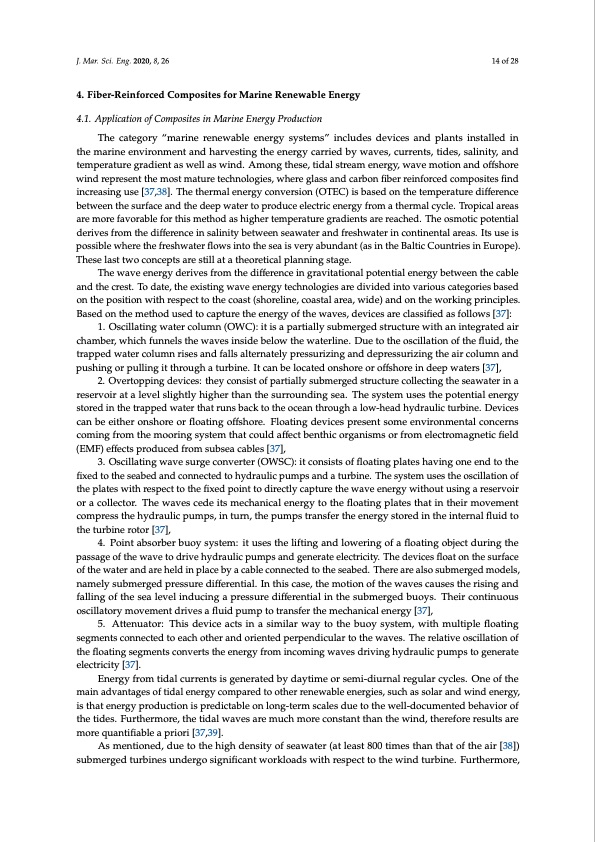
PDF Publication Title:
Text from PDF Page: 014
J. Mar. Sci. Eng. 2020, 8, 26 14 of 28 4. Fiber-Reinforced Composites for Marine Renewable Energy 4.1. Application of Composites in Marine Energy Production The category “marine renewable energy systems” includes devices and plants installed in the marine environment and harvesting the energy carried by waves, currents, tides, salinity, and temperature gradient as well as wind. Among these, tidal stream energy, wave motion and offshore wind represent the most mature technologies, where glass and carbon fiber reinforced composites find increasing use [37,38]. The thermal energy conversion (OTEC) is based on the temperature difference between the surface and the deep water to produce electric energy from a thermal cycle. Tropical areas are more favorable for this method as higher temperature gradients are reached. The osmotic potential derives from the difference in salinity between seawater and freshwater in continental areas. Its use is possible where the freshwater flows into the sea is very abundant (as in the Baltic Countries in Europe). These last two concepts are still at a theoretical planning stage. The wave energy derives from the difference in gravitational potential energy between the cable and the crest. To date, the existing wave energy technologies are divided into various categories based on the position with respect to the coast (shoreline, coastal area, wide) and on the working principles. Based on the method used to capture the energy of the waves, devices are classified as follows [37]: 1. Oscillating water column (OWC): it is a partially submerged structure with an integrated air chamber, which funnels the waves inside below the waterline. Due to the oscillation of the fluid, the trapped water column rises and falls alternately pressurizing and depressurizing the air column and pushing or pulling it through a turbine. It can be located onshore or offshore in deep waters [37], 2. Overtopping devices: they consist of partially submerged structure collecting the seawater in a reservoir at a level slightly higher than the surrounding sea. The system uses the potential energy stored in the trapped water that runs back to the ocean through a low-head hydraulic turbine. Devices can be either onshore or floating offshore. Floating devices present some environmental concerns coming from the mooring system that could affect benthic organisms or from electromagnetic field (EMF) effects produced from subsea cables [37], 3. Oscillating wave surge converter (OWSC): it consists of floating plates having one end to the fixed to the seabed and connected to hydraulic pumps and a turbine. The system uses the oscillation of the plates with respect to the fixed point to directly capture the wave energy without using a reservoir or a collector. The waves cede its mechanical energy to the floating plates that in their movement compress the hydraulic pumps, in turn, the pumps transfer the energy stored in the internal fluid to the turbine rotor [37], 4. Point absorber buoy system: it uses the lifting and lowering of a floating object during the passage of the wave to drive hydraulic pumps and generate electricity. The devices float on the surface of the water and are held in place by a cable connected to the seabed. There are also submerged models, namely submerged pressure differential. In this case, the motion of the waves causes the rising and falling of the sea level inducing a pressure differential in the submerged buoys. Their continuous oscillatory movement drives a fluid pump to transfer the mechanical energy [37], 5. Attenuator: This device acts in a similar way to the buoy system, with multiple floating segments connected to each other and oriented perpendicular to the waves. The relative oscillation of the floating segments converts the energy from incoming waves driving hydraulic pumps to generate electricity [37]. Energy from tidal currents is generated by daytime or semi-diurnal regular cycles. One of the main advantages of tidal energy compared to other renewable energies, such as solar and wind energy, is that energy production is predictable on long-term scales due to the well-documented behavior of the tides. Furthermore, the tidal waves are much more constant than the wind, therefore results are more quantifiable a priori [37,39]. As mentioned, due to the high density of seawater (at least 800 times than that of the air [38]) submerged turbines undergo significant workloads with respect to the wind turbine. Furthermore,PDF Image | Marine Application of Fiber Reinforced Composites

PDF Search Title:
Marine Application of Fiber Reinforced CompositesOriginal File Name Searched:
jmse-08-00026.pdfDIY PDF Search: Google It | Yahoo | Bing
Development of a solar powered Electric Ship The Electricship website originally started off as a project to develop a comprehensive renewable, affordable, modular electric ship... More Info
Modular Boat Hull Composite The case for a unsinkable, modular composite hybrid boat hull... More Info
MS Burgenstock Hybrid Electric Catamaran Lake Lucerne Unique shuttle servicing Lucerne to the Burgenstock Resort... More Info
Ground Power Unit GPU Powered by Lithium Ion Batteries The goal of the Ground Power Unit is to provide a readily accessible, modular, ready-to-power solution for remote power... More Info
| CONTACT TEL: 608-238-6001 Email: greg@electricship.com | RSS | AMP |